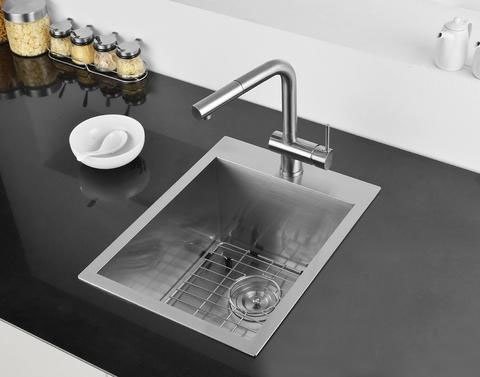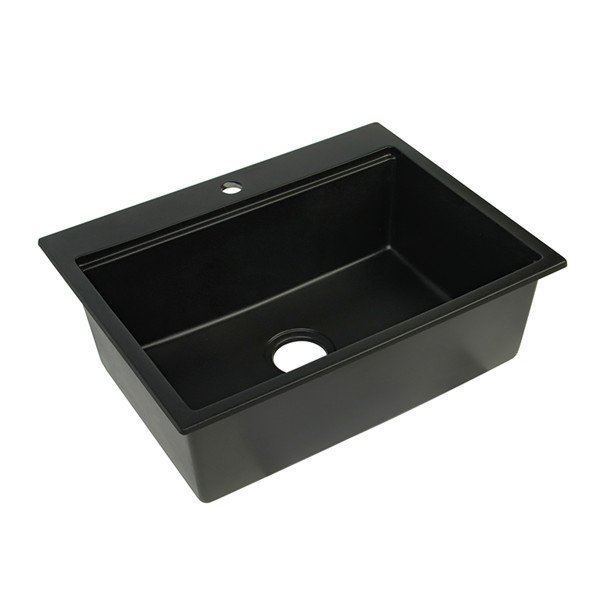If you’ve started shopping for a new kitchen sink, then you know how complicated it can be. Do you really need it to be stainless steel? How about the one with the drainboard? What about one that will fit your cabinets? Kitchen sinks come in many shapes and varieties, but figuring out which one is best for you can be quite confusing. Having a number of choices at your disposal is great, but it can also complicate things if not executed properly.
The best kitchen sink is the one that fits your needs and reflects your taste.
The best kitchen sink is the one that fits your needs and reflects your taste. A sink can become an attractive focal point of your kitchen, and it helps to have a little know-how before you go shopping for a good bargain.
Kitchen Sink Styles
The most common type of kitchen sink is the drop-in, or self-rimming style. The design features straight edges with a lip that rests on top of the countertop. This installation method is convenient because it’s easy to install and you can use any countertop surface material. It’s also less expensive than other options.

Undermount sink installation involves mounting the sink rim beneath the counter surface, which creates a smooth transition from counter top to sink basin. You’ll need a solid-surface countertop to mount this type of sink, but this design feature has some advantages. You’ll find it easier to clean since there aren’t any crevices where food or water can get trapped, and this installation method is considered sturdier than drop-in sinks because there are no rim holes for fasteners used to affix the sink basin.
Farmhouse sinks, also called apron front sinks (because of their exposed front), have become increasingly popular in recent years.
Follow these tips to buy the right sink for you.
When it comes to selecting the right sink for your kitchen or bath, there are a lot of great options to choose from. From material to style, there’s a sink that fits your needs.
Here are some important things to consider when making your purchase:
Material
Sinks are made from a variety of materials. Stainless steel is the most popular choice for kitchen sinks because it is durable and easy to maintain. The only downside to stainless steel sinks is that they can be noisy, but this can be lessened by adding sound mats under the sink.
Enameled cast iron and fireclay are two other popular choices for kitchen sinks. Enameled cast iron is extremely durable and heat-resistant, but it can chip and scratch over time. Fireclay has the same durability as enameled cast iron, but it is heavier and more expensive than other options. Copper, stone and granite are other popular materials for kitchen sinks.

Bathroom sinks are typically made out of porcelain or ceramic, although there are many other options such as glass, stone or even wood and metal. Porcelain and ceramic sinks come in a variety of colors that can easily tie into the design of your bathroom.
There are lots of materials to choose from for your kitchen sink, but stainless steel is a classic and popular choice.
There are lots of materials to choose from for your kitchen sink, but stainless steel is a classic and popular choice. If you’re considering making this type of sink part of your kitchen remodel or new build, it pays to know some of the pros and cons before you decide. Here’s what you need to know about stainless steel sinks.
Stainless steel sinks are available in a variety of configurations. You can buy a pre-made sink that comes with a faucet built into the countertop, and they can be made to fit almost any size cabinet. Stainless steel sinks also come in different install types — drop-in, undermount and farmhouse — which each have their own advantages (and disadvantages).

One big pro for stainless steel sinks is that they’re incredibly tough. They’re resistant to chipping and cracking, and they can stand up to high heat without damage. They’re also easy to clean because they’re nonporous.
On the downside, stainless steel sinks aren’t immune to damage. They can scratch, especially if you use metal scouring pads on them (use nylon or plastic instead). And if you drop something heavy on the sink, it could ding or dent it.
Style options include traditional drop-ins, undermounts, apron fronts, farmhouse style, single basin, double basins and more.
When picking out a sink, you must start by determining your budget, which will help guide you to the right material.
The next step is to figure out what type of sink you’d like: drop-in, undermount or apron front. Drop-in sinks are traditional and have a lip that sits on top of the countertop. Undermount sinks are mounted below the countertop, so the lip is not visible. Apron front sinks extend beyond the countertop and are often used for farmhouse style kitchens.
Once you’ve determined those options, it’s time to consider the shape and size of your sink. There are many shapes to choose from:
Single basin: A single-basin sink has one container and is typically used for smaller kitchens where space is at a premium. They’re also ideal for bar areas or smaller spaces in larger kitchens as secondary sinks.

Double basins: Double-basin sinks have two containers that can be equal in size or slightly different sizes depending on your needs. This type of sink usually provides enough room for washing larger items like cookie sheets and platters as well as food prep tasks like washing vegetables or rinsing dishes while keeping them separated from other dirty dishes.

Your kitchen size determines how many holes it will have for faucets or accessories such as sprayers or filtration systems.
Your kitchen size determines how many holes it will have for faucets or accessories such as sprayers or filtration systems. Typically, the larger the sink, the more holes it has. If you’re replacing an old faucet and sink, you can use the existing holes for your new faucet. If you’re installing a new sink, you can drill as many holes as needed to accommodate all your accessories.
The number of holes does not affect the price of your faucet unless it is an odd number of holes (such as five). In that case, you may need to purchase a hole cover plate in addition to the cost of your faucet.
The most common configurations are 4-inch on-center and 8-inch on-center.



